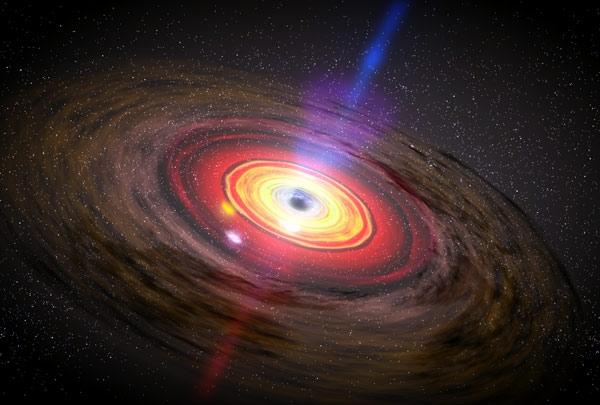Surprise discovery suggests that black holes are more complex than thought

Black holes might be more complex than scientists have thought, according to a new study, which suggests for the first time that these mysterious objects might be exerting pressure on their environment.
Known for their extremely powerful gravitational force that sucks in everything from their vicinity, black holes were originally believed to be completely inert. In 1974, famous cosmologist Stephen Hawking discovered that these superdense objects are in fact emitting thermal radiation. A new discovery, made by a team of scientists from the University of Sussex, U.K., now hints at an even more complex nature of these massive space drains.
Astronomers Xavier Calmet and Folkert Kuipers concluded that black holes exert pressure as they studied the changes in gravitational forces caused by the behavior of quantum particles at the edge of black holes and the entropy, or the available energy, of that system
Related: Watch a supermassive black hole fest in mesmerizing new simulation (video)
As they ran their calculations over and over again, an extra figure was showing up that they had no explanation for. Eventually, they concluded this unaccounted variable must represent pressure.
"Our finding that Schwarzschild black holes [static black holes without electric charge and angular momentum] have a pressure as well as a temperature is even more exciting given that it was a total surprise," Xavier Calmet, Professor of Physics at the University of Sussex, and one of the authors of the new study, said in a statement. "I'm delighted that the research that we are undertaking at the University of Sussex into quantum gravity has furthered the scientific communities' wider understanding of the nature of black holes."
The pressure exerted by the black hole, Calmet said, is rather tiny. Still, its existence might help scientists improve their understanding of the behaviour of black holes and how they marry the rather incongruous principles of quantum mechanics, thermodynamics and gravity.
Get the Space.com Newsletter
Breaking space news, the latest updates on rocket launches, skywatching events and more!
"If you consider black holes within only general relativity, one can show that they have a singularity in their centres where the laws of physics as we know them must break down," Calmet said. "It is hoped that when quantum field theory is incorporated into general relativity, we might be able to find a new description of black holes."
Folkert Kuipers, a doctoral researcher in the school of Mathematical and Physical Science at the University of Sussex and the second author of the paper, added: "It is exciting to work on a discovery that furthers our understanding of black holes."Our result is a consequence of the cutting-edge research that we are undertaking into quantum physics at the University of Sussex and it shines a new light on the quantum nature of black holes."
The discovery is described in a paper published in the journal Physical Review D on Sept. 10.
Follow Tereza Pultarova on Twitter @TerezaPultarova. Follow us on Twitter @Spacedotcom and on Facebook.
Join our Space Forums to keep talking space on the latest missions, night sky and more! And if you have a news tip, correction or comment, let us know at: community@space.com.

Tereza is a London-based science and technology journalist, aspiring fiction writer and amateur gymnast. Originally from Prague, the Czech Republic, she spent the first seven years of her career working as a reporter, script-writer and presenter for various TV programmes of the Czech Public Service Television. She later took a career break to pursue further education and added a Master's in Science from the International Space University, France, to her Bachelor's in Journalism and Master's in Cultural Anthropology from Prague's Charles University. She worked as a reporter at the Engineering and Technology magazine, freelanced for a range of publications including Live Science, Space.com, Professional Engineering, Via Satellite and Space News and served as a maternity cover science editor at the European Space Agency.









